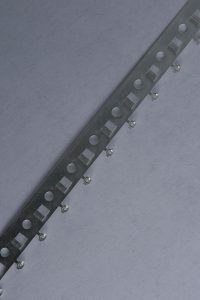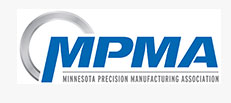 The reel-to-reel process can be more cost-effective for designers when it comes down to assembly. This process is ideal for products that need to be dimensionally stable and function in harsh environments.
The reel-to-reel process can be more cost-effective for designers when it comes down to assembly. This process is ideal for products that need to be dimensionally stable and function in harsh environments.
How It Works
Stamping and molding are combined in the reel-to-reel over molding.
The reel-to reel process involves the continuous delivery of stamped frames or components from the stamper on a disposable reel made from Masonite or plastic. The base material for the stamped frame is any material, but the most common are alloys based on nickel or copper.
The continuous perforated strip looks like a film. Pilot holes are perforations that advance the coiled strip and allow the metal strip to be in the progressive die. Pilot holes and mold cavities are positioned accurately to ensure that plastic details remain in the correct place. Pilot holes are also used to ensure that components will be aligned correctly in subsequent manufacturing operations, such as forming or bending, soldering, or welding, and assembly.
The technicians mount the reeled up, stamped frame on a payout reel that feeds the molding machine. The frame moves through the mold in a similar fashion to the feeding motion of the die after each molding cycle. The feeding unit is mounted at the start of the progressive die on the punch press and pushes strips through it.
In the opposite arrangement, the feeding unit is mounted at the end and the strip is pushed through the mold. The molding can be done in either a horizontal or a vertical machine. After the molding process is complete, the frame will be rolled back onto a reel and ready for secondary operations or shipping to the customer.
Reel improvements
Reel-to-reel systems save money by eliminating waste, reducing processing time and the need for extra equipment and personnel. This system allows for improved designs as well as lower upfront costs.
The device developer is provided with a continuously molded and oriented component, so less complex assembly tools are required.
The initial tooling costs are lower than with shuttle molding or rotary molds. Reel to reel requires just one “A” side and one “B”, whereas shuttle or rotary molding may require multiple “B”. Vertical molding is also used, which has lower hourly machine costs and part prices because of the smaller footprint and cheaper press.
Reel to reel also reduces operating costs and waste. The inserts are not placed into the mold cavity by operators, nor are they assembled into load bars. The single continuous frame eliminates (and reduces) the cost of robots or other delivery systems. The unattended, continuous operation produces a consistent and repeatable product with high quality.
The risk of mold and flash damage is virtually eliminated, as components are automatically placed. The medical device components can be costly and made of expensive alloys such as gold for plating. This process does not waste gold on the contact area of medical devices components.
The finished parts can be packaged and transported in a safe, economical manner by using a single reel.
The engineer has more freedom to design a product when the output is higher, particularly when two strips of material are fed into the mold.
Tolerances are achievable with reel-to-reel insert molding but are only limited by the type of resin used (in terms of plastic part dimensions) and the tolerances that can be maintained on the strip blank. The accuracy between metal and plastic is usually greater when the metal is thinner.Some liquid crystal polymer materials can have an accuracy of.01mm.
Best Practices
Although reel-to-reel can offer significant savings and flexibility it is important to take into consideration a few design issues and operational matters.
The part should also fit the process. Otherwise, it will take more metal to produce the same part. The part’s geometry should also be compatible with the process. For example, the carrier strip might not allow for movements to accommodate undercut features.
Monitor the strip position throughout the cycle.If the strip position is above a shut-off, it can damage the tool. Have a system in place for monitoring the quality of parts coming out of the machine, especially if there is a secondary processing line in the pipeline and the components are valuable. A technician should be able stop and fix a problem before it leads to a lot of scrap.
Reel-to-reel offers a number of benefits for medical devices.





